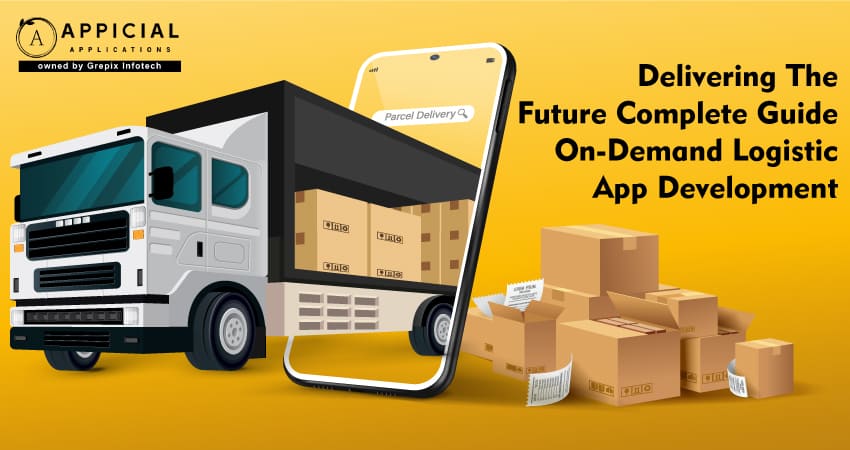
Delivering The Future: Complete Guide On-Demand Logistic App Development
It’s late at night, and you’re scrolling through your phone. You order something online, maybe it’s a gift for a loved one, maybe it’s a gadget you’ve been eyeing for weeks. And as you hit “Place Order,” you don’t think twice about how that package will find its way from the warehouse to your doorstep. You just know it will often be faster than you expected.
Behind that simple tap lies an invisible, high-speed dance of trucks, warehouses, drivers, routes, and real-time tracking. That dance? It’s powered by logistics and these days, more than ever, by on-demand logistics apps.
Once upon a time, logistics felt like a slow-moving giant, filled with paperwork, phone calls, and uncertainty about delivery times. But today? Technology has turned it into a sleek, efficient, and customer-first experience. The rise of e-commerce, the demand for same-day delivery, and our “I want it now” culture have made on-demand logistics not just a trend, but the future of how goods move.
From giant corporations shipping across continents to local businesses delivering within a city, everyone’s leaning on tech to stay ahead. And that’s where on-demand logistics app development comes in. They’ve changed the game, making it possible to manage fleets, track shipments in real-time, optimize routes, and keep customers in the loop every step of the way.
In this guide, we’ll take you behind the scenes of on-demand logistics app development. Whether you’re a logistics company looking to modernize or an entrepreneur with the next big app idea, this is your roadmap. Together, we’ll explore the features, tech, and strategies that can help you build an app that truly delivers the future.
Embark on a logistic journey with our complete guide to on-demand logistic app development. This blog post offers comprehensive insights into the essential features, technologies, and strategies required to build a successful on-demand logistic app. Whether you're a startup or an established business, this guide equips you with the knowledge to create a logistic app that stands out in the dynamic and evolving market.
The Growing Market For Logistics Apps
The size of the global logistic software market was estimated at $20.26 billion in 2022 and is projected to grow at a compound annual growth rate (CAGR) of 10.6% from 2023 to 2031 to reach $50.17 billion. The global e-commerce industry's rise is credited with the market's expansion.
Another significant change in the logistics software business is the move from cloud-based to mobile solutions. This is a result of both the sharp rise in the number of mobile users and the tendency of mobile users to be younger and more technologically literate than usual. Mobile users typically want the ability to interact with their logistics software while on the go, as well as frequent updates and new features.
Understanding The On-Demand Logistics Industry
Before diving into the app development process, it's crucial to understand the on-demand logistics industry. This sector encompasses a wide range of services, including package and food delivery, ride-sharing, freight transportation, and more. The common thread among these services is their "on-demand" nature, which means users can request a service and have it delivered promptly.
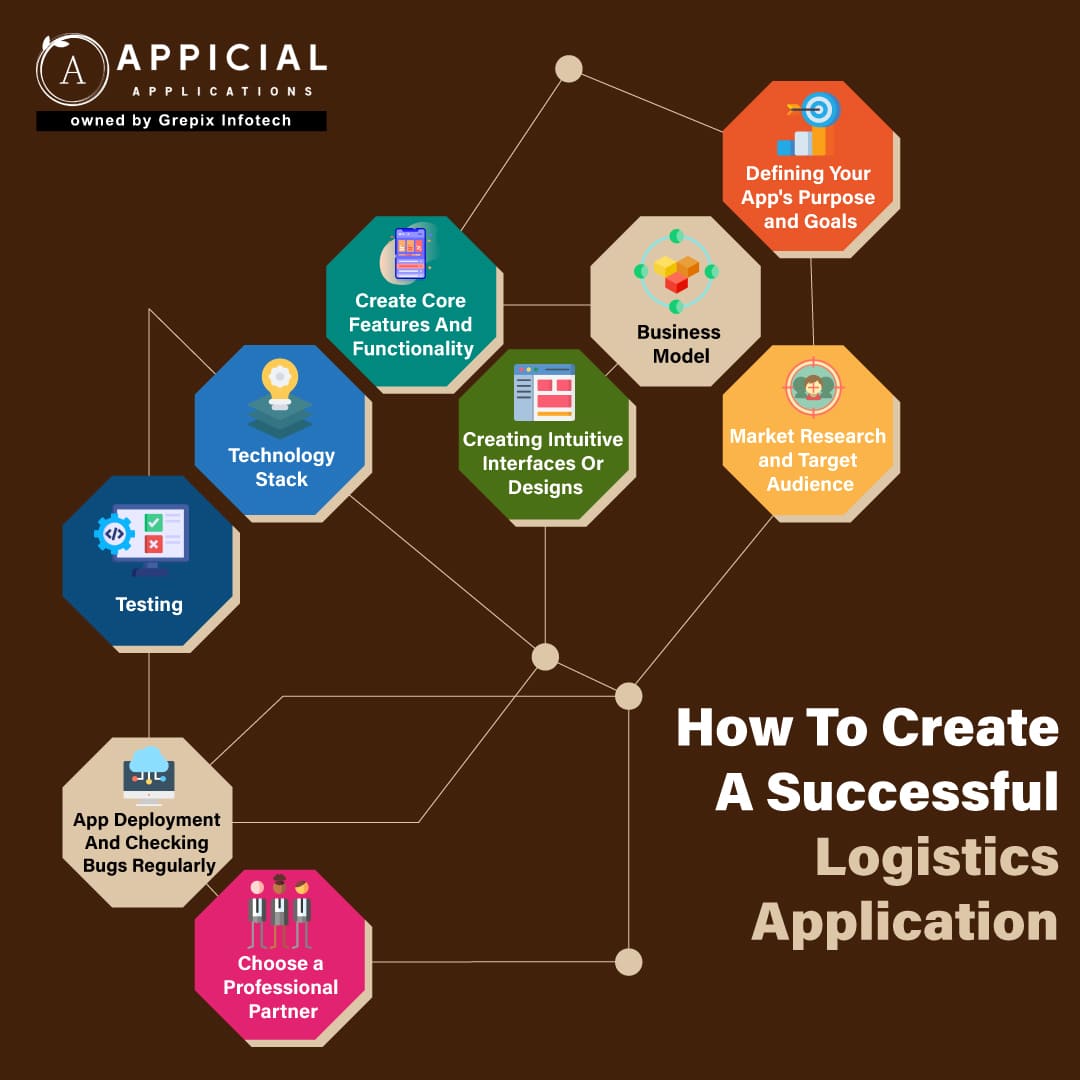
How To Create A Successful Logistics Application
1. Defining Your App's Purpose and Goals
The first step in developing an on-demand logistics app is to define its purpose and goals. What problem will your app solve, and what objectives do you want to achieve? You may want to focus on one specific aspect of logistics, such as same-day package delivery, or create a multi-service platform that offers various logistics solutions.
2. Market Research and Target Audience
Market research is essential to identify your target audience and understand the competitive landscape. Examine your potential users' demographics, inclinations, and areas of discomfort. The features, layout, and promotional plan of your app will be influenced by this research.
3. Business Model
Choosing the right business model is a critical decision. You can consider various revenue streams, such as:
- Subscription Model: Users pay a regular fee for access to your logistics services.
- Commission Model: You charge a percentage of each transaction processed through your platform.
- Advertising Model: You generate revenue by displaying ads within your app. The pricing strategy should be competitive and appealing to your target market.
4. Creating Intuitive Interfaces Or designs
User experience design is a discipline that emphasizes creating intuitive interfaces that enhance user interaction with digital products. The core principle of intuitive interface design is to make the user experience as seamless and user-friendly as possible. This involves understanding the user's needs, behaviors, and preferences and designing interfaces that align with these factors. Intuitive interfaces are consistent, visually clear, and follow familiar design patterns, ensuring that users can easily navigate the application and find the features they need.
By applying principles like progressive disclosure, feedback, and effective error handling, designers create interfaces that guide users and help them achieve their goals without frustration. Regular user testing, usability testing, and A/B testing are essential to refine and optimize the interface continually. Ultimately, creating an intuitive interface is a user-centric and iterative process that leads to a more satisfying and efficient user experience.
5. Create Core Features And Functionality
Developing core features and functionality is a pivotal phase in the creation of any software application. These core features are the heart of the application, addressing the primary needs and requirements of the users. During this phase, a clear understanding of user expectations and business objectives is essential. The process typically involves defining the scope, prioritizing features, and creating a detailed roadmap for implementation. Developers work on building the fundamental components, focusing on functionality, reliability, and performance.
It's crucial to maintain a balance between feature-rich interfaces and simplicity to ensure the core features remain user-friendly and intuitive. Regular testing and feedback collection help refine these features to align more closely with user needs, making them robust and efficient. By focusing on developing core features effectively, an application can establish a strong foundation for a positive user experience and pave the way for future enhancements and expansion.
Core features for logistics apps are essential functionalities that enable the efficient management and execution of logistics operations. These features ensure that the app fulfills its primary purpose and provides value to users. Here are some of the core features commonly found in logistics apps:
- Real-time Tracking: Provide real-time tracking of shipments, deliveries, or vehicle locations. Users should be able to monitor progress and receive updates.
- Route Optimization: Optimize routes for drivers to reduce delivery times, save fuel costs, and improve overall efficiency.
- Inventory Management:For warehouse and inventory logistics apps, offer tools for managing inventory levels, tracking stock, and fulfilling orders.
- Payment Integration:Integrate secure payment gateways for processing transactions and billing users for the services rendered.
- Messaging And Communication:
- Inventory Management:Allow users, drivers, and customer support to communicate within the app to address queries, provide instructions, or handle issues.
- Push Notifications:Implement push notifications for order updates, promotions, and other relevant alerts.
- Reviews And Ratings:Enable users to leave reviews and ratings for drivers, carriers, or service providers. This fosters accountability and trust.
6. Technology Stack
Selecting the right technology stack is a crucial step in the development process. You need to choose the appropriate programming languages, databases, and frameworks for your app. Your technology stack should be scalable and capable of handling real-time data. Building a mobile app ensures that it must run well on different tech platforms. This includes:
- Operating Systems: Android, iOS
- Types Of Apps: Native, Hybrid, Web
- Cloud Storage: AWS or Google Cloud
- Payments: Credit/Debit Card, Paypal, Stripe, Mobile Wallet, COD, etc.
7. Testing
Quality Assurance plays a pivotal role in the development of any software application, ensuring that it meets the highest standards of performance, functionality, and user satisfaction. Rigorous testing is an ongoing process that begins during the development phase and continues post-launch. It involves the systematic evaluation of every aspect of the application, from functionality and usability to security and compatibility. Testing uncovers and resolves issues, bugs, and usability concerns, ensuring a smooth and seamless user experience.
QA is more than just identifying problems; it's about verifying that the application aligns with user expectations and business requirements. By maintaining a robust testing and QA process, an application can deliver on its promises, maintain its reliability, and earn the trust of its users. This commitment to quality not only minimizes the risk of defects but also fosters user satisfaction, making it an indispensable part of the software development lifecycle.
8. App Deployment And Checking Bugs Regularly
Logistics app deployment marks the culmination of extensive development efforts and paves the way for users to benefit from the application's capabilities. This phase involves making the app available for users on various platforms, such as app stores and web-based platforms. It is essential to ensure a seamless deployment process that aligns with industry standards and user expectations. Robust testing and quality assurance are critical to identifying and rectifying any last-minute issues to guarantee a smooth user experience.
Once deployed, the app becomes accessible to a broader audience, empowering businesses and individuals to optimize their logistics and supply chain operations. Additionally, continuous monitoring, updates, and user feedback are vital post-deployment to maintain the app's performance, address emerging needs, and stay competitive in the ever-evolving logistics landscape. A successful deployment is not the end of the journey; it's the beginning of a new phase in which the logistics app can continue to evolve, adapt, and deliver value to its users.
9. Choose A Professional Partner
Selecting the right professional partner is a critical decision that can significantly impact the success of any project, whether it's app development or any other endeavor. A professional partner brings expertise, experience, and a collaborative approach to the table. They can help fill knowledge gaps, provide fresh perspectives, and offer guidance throughout the project's lifecycle.
To choose the ideal partner, one must consider factors like their track record, portfolio, and client reviews. Compatibility in terms of values, goals, and communication style is crucial for a harmonious working relationship. Ultimately, a professional partner should not just execute tasks but become an integral part of the project, contributing to its success through their knowledge and dedication.
The right partner can be a valuable asset, helping navigate challenges, leverage opportunities, and achieve your project's objectives efficiently and effectively.
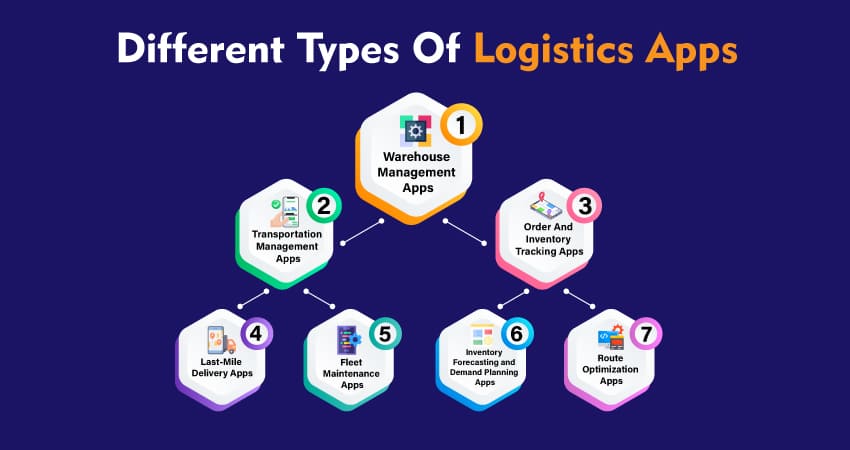
Different Types Of Logistics Apps
1. Warehouse Management Apps
Warehouse management apps are software solutions designed to streamline and optimize the operations of warehouses and distribution centers. These apps provide a range of features to help businesses efficiently manage their inventory, track stock levels, fulfill orders, and monitor various warehouse operations. Here are some examples: Standalone System, ERP Module, and Cloud-Based.
2. Transportation Management Apps
Transportation management apps are essential tools for efficiently managing the movement of goods and assets in various industries. These apps offer features for planning, optimizing, and monitoring transportation activities. They streamline route planning, enable real-time tracking of shipments, and support carrier management, ensuring that goods reach their destinations on time and at the lowest possible cost.
Transportation management apps play a critical role in enhancing supply chain visibility, reducing transportation costs, and improving overall logistics efficiency, making them indispensable for businesses seeking to streamline their transportation operations and deliver exceptional service to their customers. Here are some examples of transport management apps:
- AscendTMS Logistics Software.
- GroundCloud.
- Connecteam.
- Finale Inventory.
- Headlight Solutions.
- Radaro.
3. Order And Inventory Tracking Apps
Order and inventory tracking apps are essential tools for businesses looking to manage their stock and customer orders efficiently. These apps provide real-time visibility into inventory levels, order status, and sales trends, helping businesses reduce overstock or stockouts and improving order accuracy. With features like barcode scanning and automatic reorder points, these apps streamline the entire order fulfillment process, from receiving orders to shipping. By keeping a close eye on inventory and orders, businesses can enhance customer satisfaction, reduce operational costs, and make more informed decisions regarding their stock levels and supply chain management. Here are some examples of inventory tracking apps: Cin7, Ordoro, inFlow, Katana, ShipBob Merchant Plus, and Fishbowl Inventory.
4. Last-Mile Delivery Apps
Last-mile delivery apps are revolutionizing the final stage of the logistics process, providing consumers with swift and convenient delivery of products to their doorstep. These apps connect customers with local couriers and delivery drivers, offering on-demand and scheduled delivery services. Whether it's groceries, food, parcels, or retail items, last-mile delivery apps provide real-time tracking, accurate delivery estimates, and contactless delivery options.
They have become a lifeline for e-commerce and local businesses, enhancing the customer experience and meeting the rising demand for convenient, fast, and reliable deliveries in the last leg of the supply chain. Here are a few examples of Last Mile Delivery Software: ClickPos, OnFleet, Shipsy, Track-POD, and LogiNext.
5. Fleet Maintenance Apps
Fleet maintenance apps are indispensable tools for businesses and organizations that rely on a fleet of vehicles. These apps help ensure the smooth and efficient operation of the entire fleet by scheduling regular maintenance, tracking vehicle performance, and managing repairs and inspections.They provide real-time data on each vehicle's condition, maintenance history, and compliance with safety regulations, which not only extends the lifespan of the fleet but also enhances safety and reduces downtime. Fleet maintenance apps are instrumental in optimizing operations and reducing operational costs, making them vital for businesses that depend on their vehicles for daily operations.
Here are some top Fleet Management software:
- Azuga Fleet
- Fleetio.
- Connecteam.
- Onfleet
6. Inventory Forecasting and Demand Planning Apps
Inventory forecasting and demand planning apps are indispensable tools for businesses looking to stay ahead of customer demands and manage their inventory efficiently. These apps use data analysis and predictive algorithms to anticipate future demand and help businesses make informed decisions about inventory levels. By considering historical sales data, market trends, and seasonal variations, they assist in optimizing stock levels, reducing carrying costs, and avoiding stockouts. These apps are an essential part of supply chain management, ensuring that businesses can meet customer expectations and maximize profitability while minimizing the risks associated with overstocked or obsolete inventory.
7. Route Optimization Apps
Route optimization apps are essential tools for businesses and logistics operations seeking to streamline their transportation processes. These apps use algorithms and real-time data to calculate the most efficient routes for deliveries and services, taking into account factors like traffic, weather, and delivery windows. By minimizing travel time and fuel consumption, they reduce operational costs and improve overall efficiency. Route optimization apps benefit various industries, from delivery services to field service management, providing a competitive edge by ensuring timely and cost-effective routes, leading to increased customer satisfaction and operational savings.
Here are some examples:
- Mappr
- Onfleet
- Circuit
Customer App Feature
User features in a logistics app are functionalities designed to enhance the experience and streamline operations for individuals or businesses using the app for transportation, delivery, or supply chain management. Here are some user-focused features commonly found in logistics apps:
1. Vehicle Categories
Customers can select the vehicle from available options like 3 Wheeler, Tata Ace, Pickup 8 feet, and Tata 407 12 feet.
2. OTP On Trip Start
The customer will get a five-digit code in his app that he has to provide to the driver to start the ride.
3. Live Tracking
Customers will get real-time updates for the ride accepted, driver arrival, beginning of the ride, end of the ride, or cancellation.
4. Chat Module
Once a fleet is booked and accepted by the driver, drivers, and customers can chat via text with each other.
5. View Nearby Trucks
Customer can view the nearby available trucks in real-time to cater to their logistic needs.
6. Fare Estimation
Customers can view the detailed fare estimation for the services they opt for at the time of booking.
Driver App Feature
Driver features in a logistics app are functionalities specifically designed to streamline the experience and optimize the performance of drivers using the app for transportation and delivery services. These features help drivers efficiently manage their tasks and contribute to the smooth operation of logistics and delivery operations. Here are some common driver-focused features in logistics apps:
1. Driver Documents
Driver will upload documents (ID proof, License, Registration number), and they will be verified and approved through the admin panel to get ride requests.
2. Call / Chat
A driver can call / text to rider for any queries related to the ride.
3. Accept/Reject Ride
A driver can accept or reject the ride request received from riders within 30 seconds.
4. Earnings
Drivers can see the earning reports on a daily, monthly, and weekly basis, including all necessary details and payment methods.
5. Navigation
A driver can view navigation from the pick-up to the destination.
6. Driver’s Availability
A driver can switch their availability (On/Off) anytime within the app.
These driver-specific features are essential for ensuring a seamless and productive experience for drivers and play a crucial role in enhancing the efficiency and effectiveness of logistics and delivery services.
Admin App Feature
Logistics admin features are functionalities specifically designed for administrators, managers, and supervisors responsible for overseeing and managing the logistics and operations of a logistics app or platform. These features enable efficient monitoring, control, and decision-making within the logistics system. Here are some common logistics admin side features:
1. Revenue Manager
Admin can track daily, weekly, monthly, and total earnings.
2. Roles Manager
Admin can create sub-admins that will perform different roles as per their role assignment.
3. Transaction Manager
Detail of all the trips including fare, driver, and rider details.
4. Driver Document Verification
Admin will approve the documents uploaded by the driver.
5. Reports
Admin can track daily reports & transactions by using multiple filter options.
6. Wallet Manager
Admin can manage all transactions using the wallet.These logistics admin panel features are essential for maintaining control, oversight, and the efficient operation of logistics platforms, ensuring compliance, performance optimization, and data-driven decision-making in logistics operations.
Importance Of A Logistics App Development
Logistics app development holds immense significance in today's business landscape. These applications have become indispensable tools for businesses and organizations operating in the logistics, transportation, and supply chain sectors. Their importance stems from their ability to enhance efficiency, improve customer satisfaction, and drive cost savings.
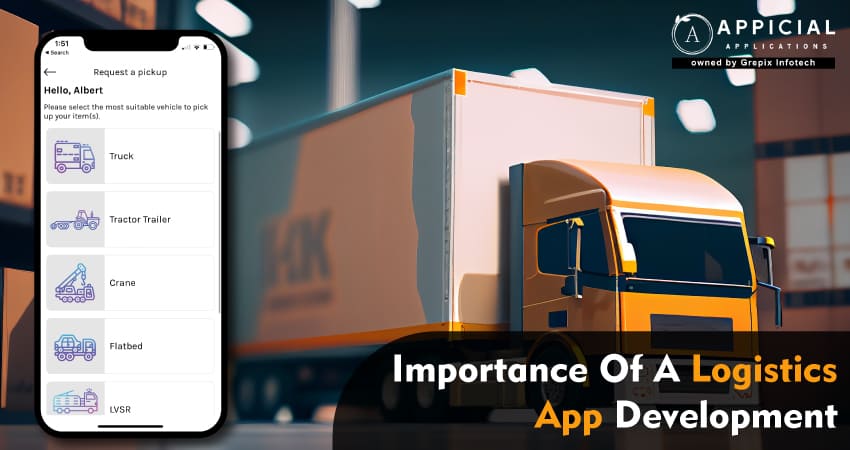
The development of a logistics app provides businesses with a competitive edge. It allows them to meet the rising customer demand for fast and reliable deliveries, positioning them ahead of competitors who rely on traditional logistics methods.The development of a logistics app holds significant importance in the modern business landscape for several compelling reasons:
Efficiency And Productivity
Logistics apps streamline operations, automate processes, and provide real-time tracking, resulting in increased efficiency and productivity. This leads to quicker order fulfillment, reduced lead times, and cost savings.
Improved Customer Experience
Logistics apps enhance the customer experience by offering real-time tracking, accurate delivery estimates, and improved communication. This leads to higher customer satisfaction and retention.
Cost Reduction
Automated route optimization and real-time tracking reduce fuel and operational costs. Better inventory management reduces carrying costs. As a result, logistics apps contribute to significant cost savings.
Enhanced Visibility
Logistics apps provide real-time visibility into the supply chain, enabling better decision-making and improved inventory management. This visibility reduces the risk of stockouts and overstock situations.
Data-Driven Insights
Logistics apps generate data and analytics that offer insights into performance, demand forecasting, and operational bottlenecks. This data-driven approach helps businesses make informed decisions.
Competitive Advantage
Implementing a logistics app can give businesses a competitive edge. It allows them to meet customer expectations for fast and reliable deliveries and keeps them ahead of competitors who may still rely on traditional logistics methods.
Scalability
Logistics apps are scalable, allowing businesses to adapt and grow as demand increases. They can handle larger volumes of orders and adapt to changing needs.
Reduced Errors
Automation reduces the risk of human errors in processes like order placement, routing, and inventory management. This results in fewer mistakes and better order accuracy.
Compliance and Regulatory Requirements
Logistics apps can help businesses maintain compliance with industry-specific regulations, such as temperature-sensitive goods in the cold chain industry or customs requirements for international shipping.
Transparency and Accountability
Logistics apps provide a transparent and accountable system, enabling businesses to track shipments, monitor driver behavior, and enhance accountability throughout the supply chain.
Environmental Impact
By optimizing routes and reducing unnecessary trips, logistics apps can contribute to a reduction in fuel consumption and greenhouse gas emissions, promoting environmental sustainability.
Operational Streamlining
The automation and optimization offered by logistics apps help streamline operations, reducing manual workloads and the need for paper-based processes.
Adaptability to Market Changes
In a dynamic market, logistics apps offer businesses the ability to quickly adapt to changes in customer demands, market trends, and supply chain disruptions.
Asset Utilization
For businesses with a fleet of vehicles, logistics apps help optimize the use of assets, reducing downtime and improving resource utilization.
In short, logistics app development is not merely a technological trend; it's a strategic imperative for businesses seeking operational excellence, customer satisfaction, and cost optimization. The importance of logistics app development lies in its ability to transform traditional logistics into a modern, data-driven, and customer-centric process that can adapt to the ever-evolving demands of the business world.
Also Read: How to Start Your Taxi Business with Indriver Clone
How Much Does It Cost To Build A Logistic App?
The cost to build a logistics app can vary significantly depending on various factors, including the complexity of the app, the features and functionalities you want to include, the platform(s) you intend to support (e.g., iOS, Android), and the location and expertise of the development team. Here are some key cost factors to consider:
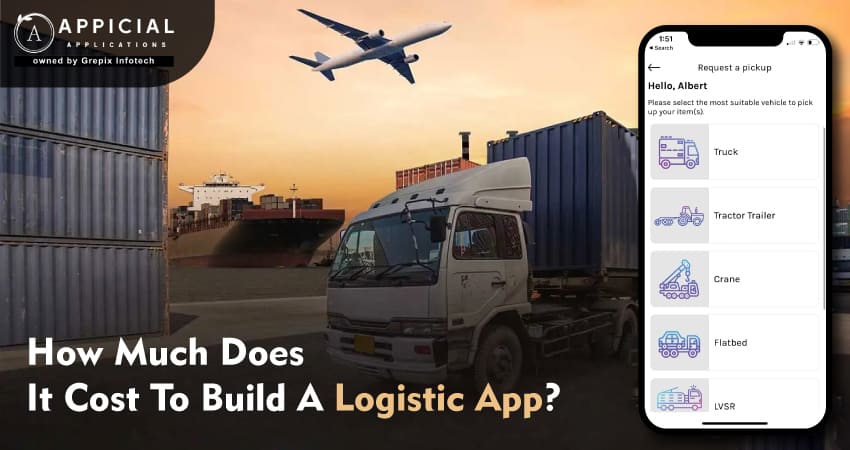
App Complexity
The complexity of the app is a major cost driver. Simple logistics apps with basic features will cost less than comprehensive apps with advanced functionalities, such as route optimization, real-time tracking, and inventory management.
Platforms
Developing the app for multiple platforms, such as iOS and Android, will increase costs. Cross-platform development frameworks can help reduce expenses.
Features And Functionality
The number and complexity of features you want to include, such as real-time tracking, payment integration, and reporting, will affect the development cost.
Design And User Experience
Creating a user-friendly and visually appealing interface can add to the cost, especially if you require custom designs and animations.
Backend Development
The development of a robust backend infrastructure to support the app's operations, such as server hosting, databases, and APIs, is a significant cost factor.
Third-Party Integrations
Integrating with third-party services or APIs for features like mapping, payment processing, or communication will incur additional costs.
Testing And Quality Assurance
Rigorous testing and quality assurance processes are crucial but add to the overall project cost.
Maintenance And Updates
Ongoing maintenance and updates post-launch are essential and should be factored into the total cost.
Regulatory Compliance
If your logistics app deals with regulated or controlled goods, complying with industry-specific regulations may entail additional development costs.
It's essential to work closely with a development team, outline your specific requirements, and receive detailed cost estimates and project timelines to get a precise understanding of the development costs for your logistics app.
How Is Appicial An Ideal Solution To Your Logistic App Development?
No matter what you think, the transportation sector has been building an on-demand logistics app to earn a significant return on investment (ROI).As the industry is growing like wildfire, you have to have an on-demand logistic app to stay ahead of your competitors.
Appicial Applications is a leading mobile app development company that develops custom mobile applications and has helped multiple businesses gain a market foothold. With a fervent crew of goal-oriented professionals, we harness state-of-the-art technology to build feature-rich, functional, beautiful, and future-ready apps that perfectly cater to your needs and budget.





